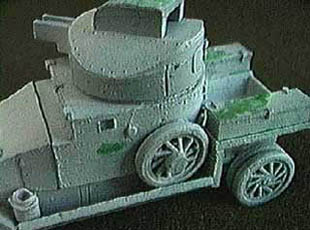Rai-Ro Green Filler Wax for Modellers
Filling Hairline Cracks and Holes

We used Rai-Ro green wax to fill the hairline gap between the bonnet and fighting compartment of this Lanchester armoured car. Minor inclusions in armour plates and stowage boxes were filled as well. The fillings can be seen as black lines and green patches. Notice that the wax has not spilled out of the filled crack on the bonnet, it can be painted without further sanding or modelling. The green patches on the stowage boxes need to be scraped with a modelling tool to remove excess wax, and the waxed areas are then brushed with silicone remover to prepare them for painting.
Tools & Accessories
- Rai-Ro ZEP-70 Wachsspachtelgerät
- Rai-Ro Filler Wax (green)
- Hylin Engraving Tool
- Soft Toothbrush
- Silicone Remover
A small bar of green filler wax is supplied with the ZEP-70, enough to get started filling small cracks in plastic or metal miniatures. The process is surprisingly easy. Dip the heated spatula into the wax to pick up a small amount of filler wax. Draw the curved tip of the spatula along the crack in the model and notice how the wax flows into it. Capillary action pulls the liquid wax into the seems. Metal models tend to be relatively cold, and the wax may harden near the surface of the crack. If this happens, draw the spatula over the crack once or twice to ensure that the molten wax flows into it nicely.
Filler wax works like magic, it beats regular fillers by a long shot. Chances are, you will never want to use another filler again:
- Filler wax is quick and easy to apply, it flows directly into the crack without covering adjacent areas. Regular fillers need to be worked into cracks carefully, to ensure that no air pockets are left.
- Filler wax hardens immediately. Regular fillers can take many hours to harden before they may be sculpted and sanded again.
- Filler wax does not shrink. Regular fillers shrink and crack as they dry, especially if large holes and cracks are filled.
- Capillary action confines the liquid wax to the crack being filled. Excess wax forms a semi-round dam above the crack, and this built-up may be scraped off easily with a modelling tool. Regular fillers are often smeared over other parts of the model, covering or dissolving the detail there.
- Filler wax may be sanded with abrasive fleece which does not destroy surface detail surrounding the filled area. Regular fillers form a needlessly hard surface, and they require vigorous sanding. Loss of important surface detail is standard operating procedure, and modellers spend an enormous amount of time reconstructing the damaged areas.
- Filler wax is not hot enough to destroy surface detail. Regular fillers may contain solvents which attack plastic surfaces, causing serious damage.
At the time of writing, Rai-Ro green wax is the fastest and most effective filler for hairline cracks, small gaps and holes in scale models.